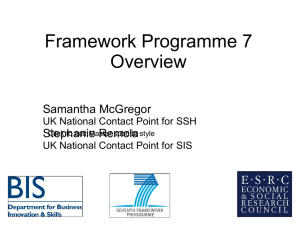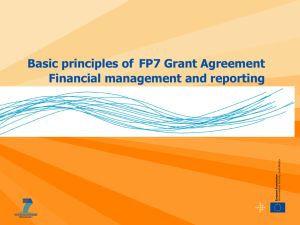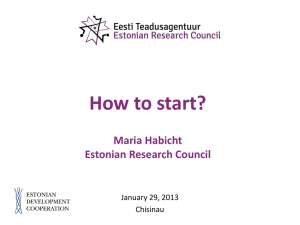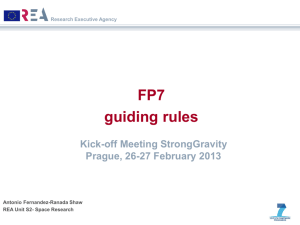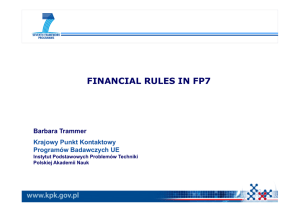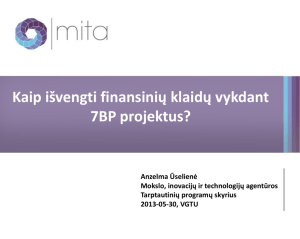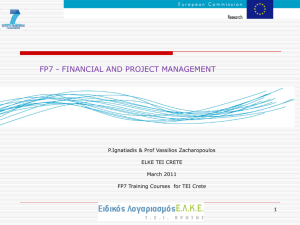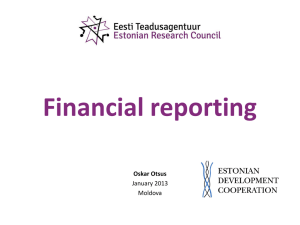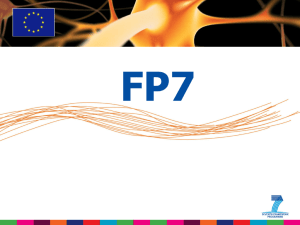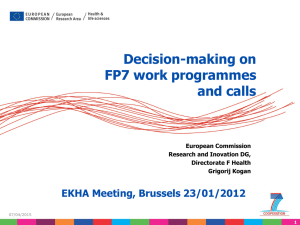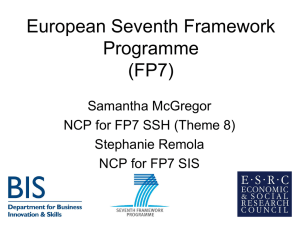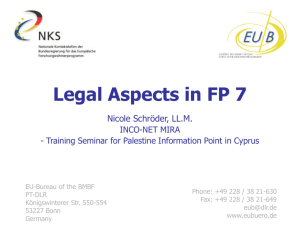L.Janssen_FP7support actions
advertisement
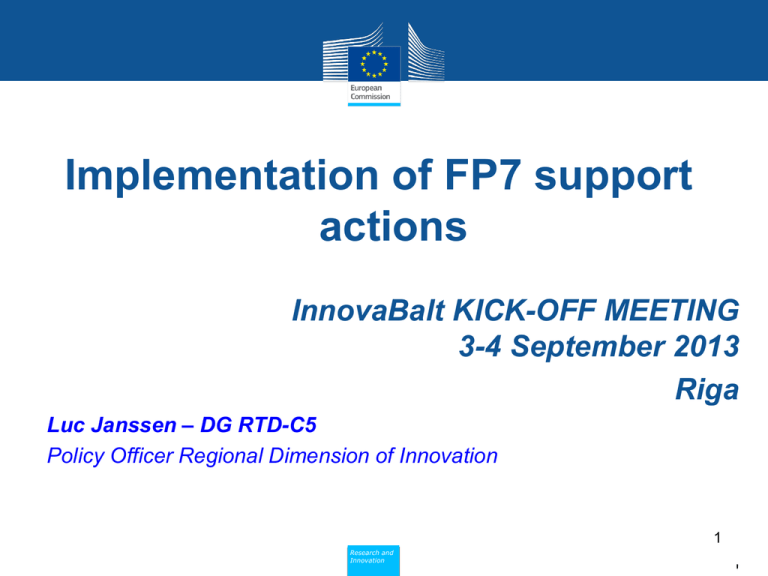
Implementation of FP7 support actions InnovaBalt KICK-OFF MEETING 3-4 September 2013 • Riga Luc Janssen – DG RTD-C5 Policy Officer Regional Dimension of Innovation 1 Policy Research and Innovation Table of contents • • • • • Aim Objectives and impact Technical and financial issues Roles Conclusion Policy Research and Innovation Aim For Gradiant: Upgrade RTD capacity & capability (human resources, scientific equipment, research management) Increase S&T excellence and visibility Integration in European Research Networks & in ERA Improvement of the participation in FP7 projects For the EU: Contribution to the regional RTD capacity building Foster the regional/European sustainable socioeconomic development Policy Research and Innovation Objectives • To unlock the Research Potential of the European Union by integrating the excellent research entities established in the EU’s convergence regions and outermost regions into the ERA • To strengthen the capacities of selected research organisations to successfully participate in European research activities & in the EU Research Framework Programmes • To reinforce cooperation with at least 3 European outstanding research ‘partnering organisations’ (in the same S&T domain or in a complementary field) established in 3 different member states - Not legally binding Policy Research and Innovation Expected Results • Exchange of know-how and experience through trans-national two-way secondments of research staff between Gradiant and the ‘partnering organisations’ • Recruitment of experienced researchers • Upgrade research equipment • Organisation of workshops and conferences – dissemination and promotional activities – publications for knowledge sharing and better visibility Policy Research and Innovation Reporting • All reports (scientific and financial) have to be submitted electronically via the Participant Portal: http://ec.europa.eu/research/participants/portal/ • The financial reports will be submitted via the Participant Portal through Forms C At the end of each reporting period, the Commission shall evaluate and approve project reports and deliverables and disburse the corresponding payments within 90 days of their receipt (Art II.5.1). Policy Research and Innovation During the course of the project Deliverables To be submitted: 1. The deliverables identified in Annex I to the Grant Agreement, according to the timetable specified in the Deliverables list. 2. A periodic report within 60 days of the end of each reporting period (including the last reporting period). The periodic report comprises: a) An overview + a publishable summary of the progress of work towards the objectives of the project. This report should include the differences between work expected to be carried out in accordance with Annex I and that actually carried out b) An explanation of the use of the resources c) A Financial Statement: Form C (Annex VI to the Grant Agreement) together with a financial report. Policy Research and Innovation Final report At the end of the project In addition to the periodic report for the last period of the project, a final report has to be submitted, within 60 days after the end of the project. This final report shall comprise: a) An overview final publishable summary report which includes: an executive summary, a summary description of project context and objectives, a description of the main S&T results, the potential impact (including the socio-economic impact of the project) and the main dissemination activities and exploitation of results/foregrounds b) A plan for the use and dissemination c) A report covering the wider societal implications of the project, in the form of a questionnaire, including gender equality actions, ethical issues, efforts to involve other actors. Policy Research and Innovation Financial issues Art II.7 Subcontracting Art II.7.3: Minor tasks The criteria to decide whether a subcontract concerns minor tasks are qualitative and not quantitative: Examples: • Organisation of the rooms and catering for a meeting • Printing of material, leaflets, etc. Art II.14.3: Non-eligible costs • VAT is not eligible. The particular case of airport taxes In general, airport taxes are not real taxes in the sense of tax law but a fee for a service delivered by a public or semi-public body in charge of a (public) service, such as airports (independent of the fact that that some airports might have a private legal form). In this case the airport taxes imposed by these authorities may be considered a fee and therefore is eligible. Policy Research and Innovation Direct/indirect costs Art II.15: Identification of direct and indirect costs Direct costs Direct costs are all those eligible costs which can be attributed directly to the project and are identified by the beneficiary as such, in accordance with its accounting principles and its usual internal rules. Example: The cost of personnel assigned to the project Only the costs of the actual hours worked by the persons directly carrying out work under the project may be charged (need to use Timesheets to record hours– Art II.15 - a.1). Indirect costs Indirect costs are all those eligible costs which cannot be identified by the beneficiary as being directly attributed to the project, but which can be identified and justified by its accounting system as being incurred in direct relationship with the eligible direct costs attributed to the project. Policy Research and Innovation Equipment Art II.15 (c): The purchase cost of durable equipment Only equipment purchased for the purposes of carrying out the action can be charged as direct costs. To be considered as eligible, a cost must be determined according to the beneficiary's usual accounting practice and each beneficiary must apply its usual depreciation system for durable equipment. Depreciation is charged in each relevant periodic report. Depreciated costs of equipment can never exceed the purchase price of the equipment. A particular regime applies to all projects financed under the Programme "Research Potential“ as the acquisition of research equipment is one of the core activities of the Research Potential Programme. Consequently, the EU will bear up to the total cost of the research equipment (except VAT), regardless of the depreciation used by the beneficiary. In this specific context, the beneficiary could therefore charge up to the full price of equipment identified in Annex I. In any event the equipment cannot be charged to any other EU project. Policy Research and Innovation Project Officer • • • • Organises the evaluation of proposals Contract negotiation Project management and monitoring Specific tasks on Unit and Directorate level • Interservice consultation, reports • Programme committee • Organisation of workshops, conferences (WIRE), etc. 12 Policy Research and Innovation Role of the Project Officer • My job is to catalyze the interactions between the Consortium and the European Commission ● Ensure that the Consortium fulfills the contract with the EC (deliverables) ● Monitor the scientific, technological and financial execution of the project ● Assess the eventual deviations to the DoW proposed by the Coordinator during the project’s implementation ● Accept (or not) the eventual amendments proposed by the Coordinator during the project’s implementation ● Carry out assessment, analysis and approval of project’s reports and deliverables ● Ensure that money is transferred as quickly as possible 13 Policy Research and Innovation Role of the COORDINATOR Technical, administrative and financial management Intermediary, contact with the Commission – single entry point consolidates reports from participants and work packages Submits all documents and informs the Commission Reports on use of financial resources Receives all payments and transfers the appropriate amounts to each contractor Chairs the Steering Committee (by default) Oversees the project progress, makes proposals to adapt the project plan 14 Policy Research and Innovation Eligible Costs (1) Eligible actual* during duration of project in accordance with its usual accounting and management principles recorded in the accounts of beneficiary used for the sole purpose of achieving the objectives of the project Non-eligible (identifiable indirect taxes including VAT…) 15 Policy Research and Innovation Eligible Costs (2) Average personnel costs accepted if : Consistent with the management principles and accounting practices AND they do not significantly differ from actual personnel costs = if identified according to a methodology approved by the Commission 16 Policy Research and Innovation Project Management You will be doing project and results cannot be predicted Thus: • Changes are expected • Changes will be accepted BUT • Inform the EC as early as possible • Suggest what should be done to compensate . Policy Research and Innovation 17 Conclusion To ensure the sustainability of your project , be sure to: • To line-up with regional/national priorities/roadmaps • to deepen your excellence and integrate with ERA • to build up a strong network with all the relevant stakeholders (partnering organisations, SMEs, public and private partnership) Policy Research and Innovation THANK YOU for your attention! I count on ALL of you to make this project a real ‘SUCCESS’ 19 Policy Research and Innovation Useful references on Cordis Model Grant Agreement and annexes: http://cordis.europa.eu/fp7/calls-grant-agreement_en.html#standard_ga Guide to Financial Issues relating to FP7 indirect actions: ftp://ftp.cordis.europa.eu/pub/fp7/docs/financialguide_en.pdf Rules to ensure consistent verification of the existence and legal status of participants: ftp://ftp.cordis.europa.eu/pub/fp7/docs/rules-verif_en.pdf Checklist for a consortium agreement for FP7 projects: ftp://ftp.cordis.europa.eu/pub/fp7/docs/checklist_en.pdf Guides to Intellectual Property Rules for FP7: ftp://ftp.cordis.europa.eu/pub/fp7/docs/ipr_en.pdf 20 Policy Research and Innovation
